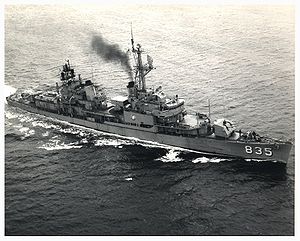- USS Charles P. Cecil (DD-835)
-

USS Charles P. Cecil, 1971Career (United States) 
Name: USS Charles P. Cecil (DD-835) Namesake: Charles P. Cecil Builder: Bath Iron Works, Bath, Maine Laid down: 2 December 1944 Launched: 2 April 1945 Commissioned: 29 June 1945 Reclassified: DDR-835, 18 March 1949 Decommissioned: 1 October 1979 Fate: Sold to Greece, 8 August 1980 Career (Greece) 
Name: Apostolis (D216) Acquired: 8 August 1980 Commissioned: 1980 Struck: 1993 Fate: Sold for scrap, March 2003 General characteristics Class and type: Gearing-class destroyer Displacement: 3,460 long tons (3,516 t) full Length: 390 ft 6 in (119.02 m) Beam: 40 ft 10 in (12.45 m) Draft: 14 ft 4 in (4.37 m) Propulsion: Geared turbines, 2 shafts, 60,000 shp (45 MW) Speed: 35 knots (65 km/h; 40 mph) Range: 4,500 nmi (8,300 km) at 20 kn (37 km/h; 23 mph) Complement: 336 Armament: • 6 × 5"/38 caliber guns
• 12 × 40 mm AA guns
• 11 × 20 mm AA guns
• 10 × 21 in (533 mm) torpedo tubes
• 6 × depth charge projectors
• 2 × depth charge tracksUSS Charles P. Cecil (DD-835) was a Gearing-class destroyer, the only ship of the United States Navy to be named after Rear Admiral Charles P. Cecil. She was launched on 22 April 1945 by Bath Iron Works, Bath, Maine; sponsored by Mrs. C. P. Cecil; and commissioned on 29 June 1945 with Commander W. Outerson in command.
Service history
Charles P. Cecil arrived at San Diego, her home port, on 20 November 1945, and almost at once sailed on a tour of Pacific duty which found her operating as part of Joint Task Force One in the atomic bomb tests at Bikini Atoll, as well as supporting occupation forces with operations in Japanese waters. She returned to San Diego on 9 August 1946, and took part in exercises off the west coast until on 26 August 1947, when she cleared for her second deployment to the Far East. She touched at many Pacific islands as well as calling at ports in China, Japan and Okinawa before her return to San Diego on 5 May 1948.
Reclassified DDR-835 on 18 March 1949, Charles P. Cecil left San Diego astern on 4 April 1949, bound for Newport, Rhode Island, and assignment to the Atlantic Fleet. First from Newport, and from December 1950, from Norfolk, Virginia, Charles P. Cecil operated through 1960 with the Atlantic Fleet, taking part in midshipmen training cruises, periodic deployments to the Mediterranean, and the overhauls and refresher training necessary to maintain her readiness. She participated in a long list of NATO operations, in waters ranging from those north of the Arctic Circle to the Mediterranean. Her tours of duty with the 6th Fleet in the Mediterranean included one which coincided with the Suez Crisis of fall 1956, during which she took up watchful patrol in the eastern Mediterranean.
From January 1959, when she was fitted with highly complex electronic computational and tracking equipment, Charles P. Cecil concentrated on air defense experiments and exercises, contributing to the development of advanced techniques. Her training, however, continued to include the areas such as anti-submarine warfare and amphibious operations required of the versatile destroyer.
Charles P. Cecil participated in thirteen Mediterranean cruises, two Middle East cruises, and two Vietnam cruises; She was one of the first ships on the Cuban Quarantine Line in the fall of 1962, there she was the principal unit that exhausted a Russian submarine and forced her to surface.
In July 1973 Charles P. Cecil was assigned to naval reserve squadron COMDESRON TWO EIGHT and homeported in New London, Connecticut.
Charles P. Cecil was struck from the United States Navy's rolls of fighting ships on 1 October 1979 and subsequently sold to Greece and renamed Hellenic Navy until she was decommissioned in 1993. She was scrapped in March 2003.
References
- This article includes text from the public domain Dictionary of American Naval Fighting Ships. The entry can be found here.
External links
- Photo gallery of USS Charles P. Cecil at NavSource Naval History
Categories:- Gearing class destroyers of the United States Navy
- Ships built in Maine
- 1945 ships
- World War II destroyers of the United States
- Cold War destroyers of the United States
- Vietnam War destroyers of the United States
- Gearing class destroyers of the Hellenic Navy
Wikimedia Foundation. 2010.
